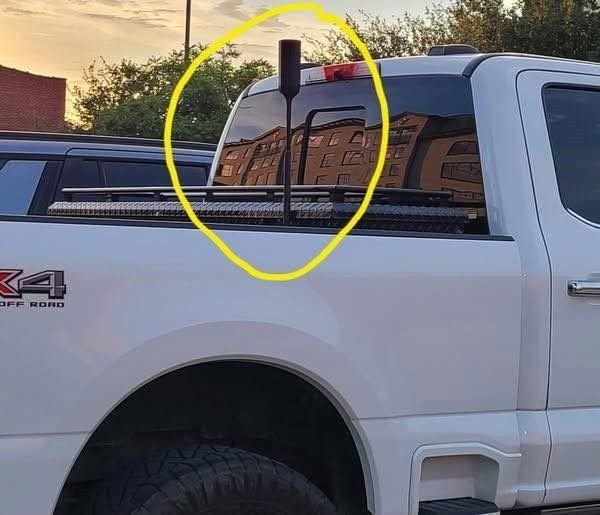If you’ve spent time on highways or country roads, chances are you’ve noticed trucks with tall, thin poles rising above their roofs. At first glance, they look like old CB radio antennas—the kind truckers once used to chat with each other about traffic or weather. Some people think they’re just a leftover decoration, a relic from a different era.
But the truth is far more fascinating. That simple-looking rod is actually a cell phone signal booster antenna, and it plays a critical role in keeping drivers connected. In a world where so much depends on reliable communication—whether it’s calling for help, staying in touch with loved ones, or simply following GPS on unfamiliar roads—these antennas are a modern lifeline.
Not Just a Throwback to the Past
For those of us who remember the heyday of CB radios, these antennas may seem like a nostalgic nod to the past. But today, they’re part of a far more advanced system. Instead of carrying truck-to-truck conversations, they work with technology that pulls in weak or fading cell phone signals, strengthens them, and then redistributes them inside the vehicle.
In plain terms, they make sure you can use your phone—even in places where service usually drops out. That’s why more truckers, farmers, contractors, and RV travelers are adding these systems to their vehicles.
How a Signal Booster System Works
At the heart of this technology is something called a mobile signal booster. The external antenna is just one piece of the puzzle, though it’s the most visible part.
Here’s how the system comes together:
- External Antenna
This is the tall rod you see mounted on trucks. Its job is to reach out and “grab” faint signals that your phone’s tiny built-in antenna can’t detect. - Amplifier Inside the Vehicle
Once the external antenna pulls in a weak signal, the amplifier takes over. It boosts that signal, sometimes by a factor of 30 or more. - Internal Antenna
Finally, the strengthened signal is rebroadcast inside the truck or RV. This allows all mobile devices inside—phones, tablets, even mobile hotspots—to connect with a strong, reliable signal.
The result? Calls don’t drop as easily, GPS works in more places, and mobile data becomes fast enough for email, browsing, or even streaming. For truck drivers and rural travelers, this can mean the difference between staying connected and being cut off entirely.
Why These Antennas Matter More Than Ever
There was a time when spotty cell service was just an inconvenience. But today, being without a signal can affect everything from safety to work to peace of mind.
- Safety on the Road: Imagine breaking down in a remote area without service. With a cell phone booster, even faint signals can be strengthened enough to call for help.
- Staying on Schedule: Contractors, delivery drivers, and farmers depend on clear communication to keep work running smoothly. Missed calls or poor data can cause delays that cost money.
- Peace of Mind for Travelers: Families on road trips or retirees exploring the country in RVs feel more at ease knowing they can always reach loved ones or use GPS to stay on course.
For older drivers in particular, this technology adds a sense of security. It ensures that no matter how far the road takes you, you’re never truly disconnected.
Who Benefits the Most from Truck Antennas and Signal Boosters
While almost anyone could find use for these systems, they’re especially valuable for people whose lives and work take them far from big cities.
- Farmers and Ranchers: On large properties where cell towers are miles away, boosters keep workers connected across fields and barns.
- Truckers and Delivery Drivers: Long-haul and regional drivers rely on them to keep logistics flowing and to stay in touch with dispatchers.
- Campers and RV Travelers: Retirees and families who love to hit the open road no longer have to sacrifice communication when they head into rural or mountain areas.
- Outdoor Workers: Contractors, linemen, and emergency crews use boosters so they can coordinate projects without worrying about losing signal.
Popular Models and What They Offer
A growing market has made signal boosters more affordable and user-friendly. Some of the most recognized models include the weBoost Drive Reach and the HiBoost Travel 3.0.
These units:
- Work with all major U.S. carriers (Verizon, AT&T, T-Mobile, etc.).
- Allow multiple devices to connect at once.
- Provide both voice and data improvements.
That means passengers can send emails, browse the internet, and even stream movies during long trips—something that makes cross-country drives far more enjoyable.
The Cost of Staying Connected
Of course, modern convenience comes with a price. A full signal booster kit usually costs between $300 and $500. While that may sound steep for casual drivers, for those who frequently travel through low-service areas, the investment is worth every penny.
Think about the alternatives:
- Being stranded without the ability to call for roadside help.
- Losing contact during important business deliveries.
- Not being able to use GPS when you need it most.
In those moments, a booster system proves itself as a necessity rather than a luxury.
The Connection to the Past
There’s a touch of poetry in how these antennas look. They stand tall, just like the CB radio antennas of the past, yet they serve a completely different role. In the 1970s and 80s, truckers used CB radios to warn each other about road conditions, weather, or traffic. Today, smartphones have taken over that job, but the visual reminder remains.
In many ways, the antennas symbolize how driving culture has evolved. The independence of the open road remains, but it has merged with the need to stay digitally connected. The spirit of freedom hasn’t disappeared—it’s simply adapted.
Why You’re Seeing More of Them Today
The rise of remote work, road trips, and outdoor adventures has created a greater need for reliable mobile connectivity. Retirees in RVs, young families on camping trips, and off-road enthusiasts all want the freedom to explore without losing touch.
As a result, more trucks, SUVs, and RVs are sporting these tall antennas. They’ve quietly become a common sight, and now you know why.
The Next Time You See One
So the next time you’re driving and spot a truck with a tall antenna, you’ll know it’s not just decoration and not simply a throwback to the CB radio era. It’s a modern signal booster antenna, a piece of technology that keeps drivers safe, families connected, and workers productive.
In a way, it bridges two worlds: the rugged independence of the open road and the digital demands of modern life. For older generations who once associated these poles with CB radios, it’s a reminder that technology keeps moving forward—but it still serves the same purpose of keeping people connected.
And in the end, that connection is what matters most.



